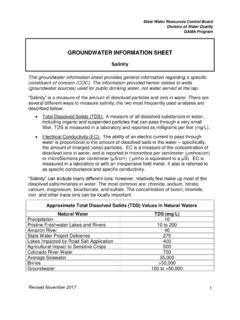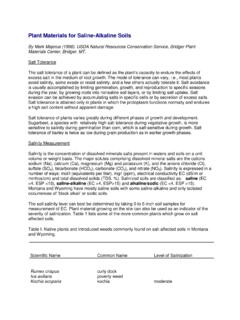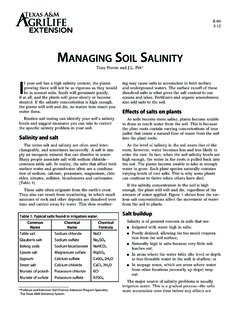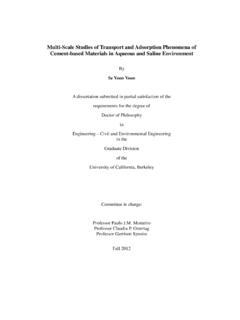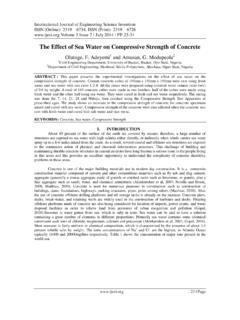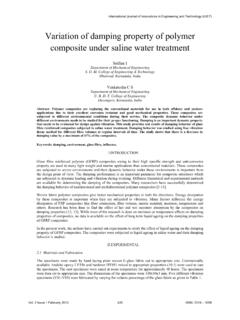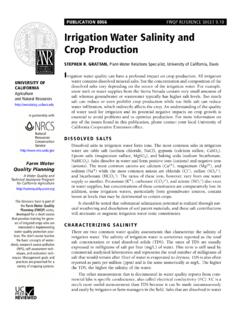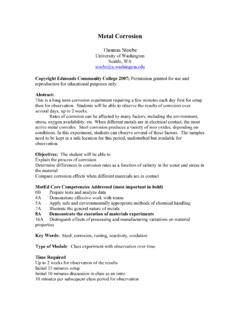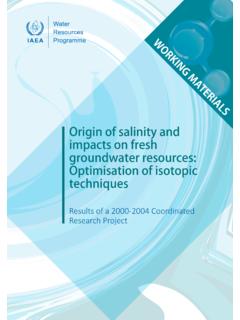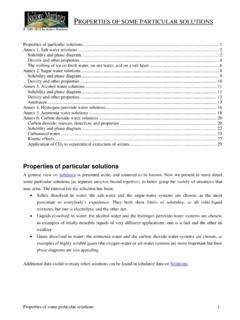Transcription of IRRIGATION - Attra
1 IRRIGATION . Barbara Bellows, NCAT Soils Specialist IRRIGATION 2004 NCAT Slide 1. 800-346-9140 Sustainable IRRIGATION IRRIGATION practices farmers can continue to use to produce agricultural products at reasonable cost while ensuring that IRRIGATION and drainage do not degrade the quality of land, water , or other natural resources IRRIGATION Slide 2. Un-sustainability of IRRIGATION Globally, 71% of withdrawn freshwater is used for IRRIGATION Rivers dammed to collect IRRIGATION water People living in areas behind the dams are displaced Wildlife habitat destroyed IRRIGATION depletes rivers and aquifers IRRIGATION degrades water , soil, and wildlife habitat IRRIGATION Slide 3. Access to IRRIGATION water Government support of IRRIGATION Historically, allowed crop production in areas where they would not thrive without IRRIGATION Greater water -use competition increasingly reduces water availabile to agriculture IRRIGATION water availability Requires permit in many states Permit process causes inequities among agricultural producers IRRIGATION Slide 4.
2 IRRIGATION and water Rights Ground- and surface- water rights vary by state California: First person to claim owns rights to water South Dakota: All water is the property of the state Unresolved water rights / water use issues Who owns conserved water ? water banking (storage and reserve). water pricing: urban vs. rural, large vs. small farms water futures (stock trading). IRRIGATION Slide 5. water Competition Supply problems Increased water demand for IRRIGATION Decreased availability of good-quality water Economic problems Increased competition with urban water users water rationing Increased cost of IRRIGATION water water available but not sufficient or available only at the wrong time IRRIGATION Slide 6. Competing water Demands Agricultural use Residential use Industrial / commercial use Industry, bottled water Tourism: hotels, fountains, golf courses, boating water levels for commercial shipping water levels for wildlife / fish habitat IRRIGATION Slide 7.
3 Future of IRRIGATION water available for IRRIGATION will decrease Increased demand for water quality, urban water use Increased economic competition for water water use decisions will be at the watershed level Global competition for agriculture products Affects prices of agricultural products Determines profitability of irrigated crops Favors larger, diversified farms IRRIGATION Slide 8. Sustainable IRRIGATION Extract only the amount of water that can be replenished through recharge Apply water efficiently Minimize losses during delivery to site and application to crops Apply only the amount of water the crop needs Minimize downstream environmental damage Protect water quality to protect IRRIGATION water Isolate, reuse, or dispose of saline drainage water IRRIGATION Slide 9.
4 Limited IRRIGATION Reduce irrigated acreage Grow primarily crops that use less water Manage soils to capture and hold precipitation Reduce IRRIGATION water applied Apply water as needed to obtain best economic returns Delay IRRIGATION until plants reach critical need for water water reuse Reuse IRRIGATION water prior to discharge Use municipal waste water for IRRIGATION IRRIGATION Slide 10. Limited IRRIGATION Management Limited IRRIGATION provides the best economic returns rather than the highest yields Especially important where IRRIGATION water is not sufficient to meet crop demands High competing demands for water Ground and surface water reserves are being depleted Quality of available IRRIGATION water is being degraded IRRIGATION Slide 11.
5 Reduce Irrigated Acres Plant dryland crops that require less water Increase moisture-holding capacity of dryland soils Use mulches and cover cropping Employ minimum tillage practices Increase soil organic matter Decrease evaporation by planting windbreaks Increase water -use efficiency on irrigated land, to obtain the same production on less land IRRIGATION Slide 12. Increase IRRIGATION Efficiency Reduce seepage loss Reduce evaporation in fields Schedule IRRIGATION based on soil moisture and plant needs Do not over-fertilize crops Control weeds that compete for water Time planting to take greatest advantage of natural precipitation IRRIGATION Slide 13. Efficiency of IRRIGATION Methods Flood least efficient Furrow Sprinkler Center-pivot Wheel line Micro- IRRIGATION most efficient Trickle, drip, spray Wetting pattern of drip tape Above ground, below ground IRRIGATION Slide 14.
6 Flood IRRIGATION Benefits Good for small, irregularly- shaped fields Low cost if water is relatively cheap Flushes salts out of the soil Requires flat fields so water does not pool Concerns High water loss through evaporation and leaching Anaerobic environment promotes nitrogen loss IRRIGATION Slide 15. Furrow IRRIGATION Benefits Good for small, irregularly- shaped fields Relatively inexpensive where water costs are low Requires furrows designed to distribute water evenly Concerns High water loss by leaching, seepage, and evaporation High potential for waterlogging and salinization IRRIGATION Slide 16. Sprinkler IRRIGATION Benefits More efficient than flood or furrow Good for medium to large fields Land can have a moderate slope Concerns water loss through evaporation Wet leaves from IRRIGATION favors foliar diseases White leaf spots if IRRIGATION water has bicarbonates IRRIGATION Slide 17.
7 Micro- IRRIGATION : Trickle, Drip, or Spray Benefits More than 90% efficient Can be used on hilly land Can use relatively saline water Programmable Concerns Expensive to install and maintain Clogging of water emitters if water quality is poor Can cause localized salinity at edge of wetting zone IRRIGATION Slide 18. Drip IRRIGATION Maintenance Clogging Problem Maintenance Treatment Suspended materials Filter water with 200. mesh filter Chemical precipitation of Add acid to IRRIGATION line bicarbonates and iron Biological growth Add chlorine to IRRIGATION line WARNING!!! DO NOT MIX ACID AND CHLORINE IN SAME CONTAINER. IRRIGATION Slide 19. IRRIGATION Scheduling Monitoring moisture availability Crop stage of growth and vigor Air temperature and wind speed Rainfall or IRRIGATION water applied Soil moisture Calculations Daily crop water use or evapo-transpiration Soil water balances and water available to plants IRRIGATION Slide 20.
8 Evapo-transpiration Evapo-transpiration is water evaporation from the soil and transpiration from plant leaves Factors affecting evapo-transpiration Climate: wind speed, temperature, humidity Field aspect or solar exposure Crop type Stage of crop growth Soil moisture Soil cover IRRIGATION Slide 21. Evapo-transpiration Estimations Evaporation pan Determine allowable water depletion for soil type and crop being grown Set up pan with water in sun with the allowable soil water depletion level marked below initial water level Irrigate when water evaporates to marked level AgriMet Network for local and regional weather Provides evapo-transpiration measurements by station IRRIGATION Slide 22. water Availability Soil water -holding capacity Silt and clay provide good water holding capacity; clay restricts water infiltration and drainage Organic matter increases water holding capacity Plant available water Amount of water plants can use before starting to wilt Affected by type of plant, stage of growth, rooting depth Mulches that limit evaporation increase available water IRRIGATION Slide 23.
9 Soil Moisture Estimate water available to plants Measurement methods Tensiometers Gypsum blocks Lysimeters Feel method Soil probe Assess moisture by rooting depth IRRIGATION Slide 24. Soil Moisture Estimation by Feel Method Descriptions are for sandy loam soils Moisture Description content 0 25% Ball of soil is weak and grains break away quickly 25 50% Soil ball is weak, but finger marks show 50 75% Moist ball, dark color, light soil stain on fingers 75 100% Moist soil ball, medium soil stain on fingers IRRIGATION Slide 25. Plant Available water The difference between the amount of water currently in the soil and the amount of water in the soil when the crop is at the wilting stage Determined by rooting depth of crop Combines soil moisture and crop growth stage At critical growth stages, less than 40 60%.
10 Plant available water causes plant stress Estimates available through Agri-Met IRRIGATION Slide 26. Environmental Impacts of IRRIGATION Depletes water from lakes, rivers, and aquifers Degrades and destroys wildlife habitat Degrades soil quality Degrades water quality Decreases agricultural productivity and profitability IRRIGATION Slide 27. Freshwater Depletion water use is greater than water recharge Excess surface water use depletes rivers, causing them not to reach the sea Excess ground water use causes Stream levels to drop within 30 years Land subsidence Limited snow pack during droughts decreases recharge and water availability IRRIGATION Slide 28. IRRIGATION water Reuse Benefits Increases IRRIGATION water supply in district Decreases discharge of saline water into rivers Reuse methods Blend used, saline IRRIGATION water with fresh water Use this water to irrigate salt-tolerant crops In next rotation, use fresh IRRIGATION water to grow crops that are less salt-tolerant Repeat this rotation cycle IRRIGATION Slide 29.

